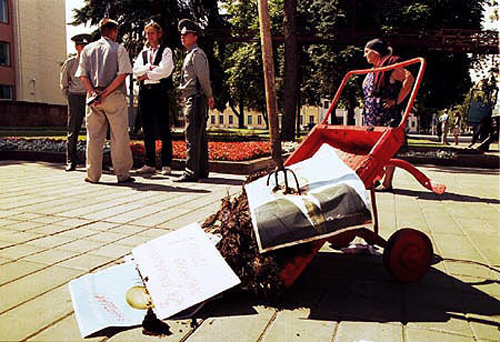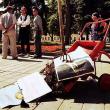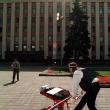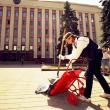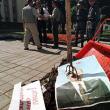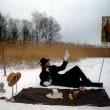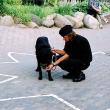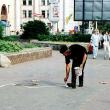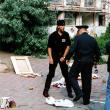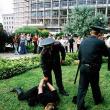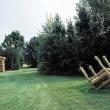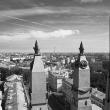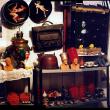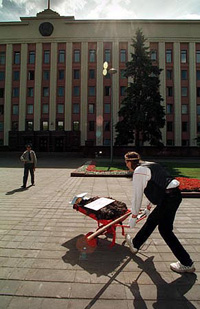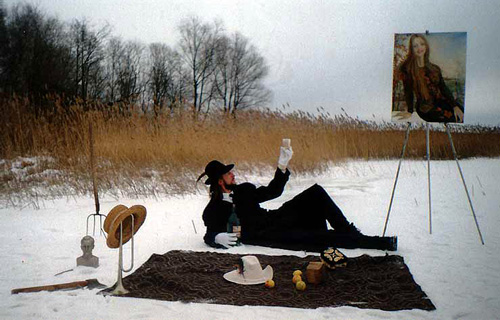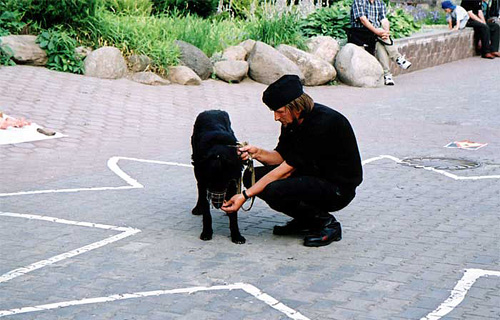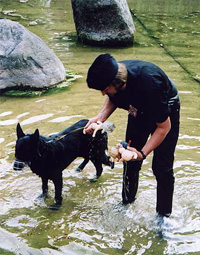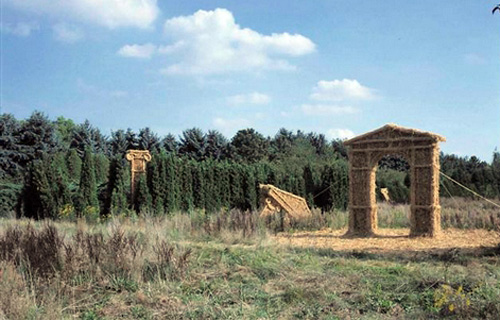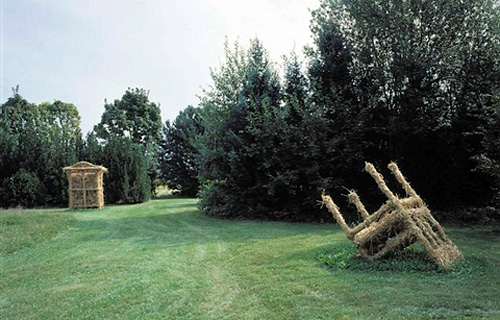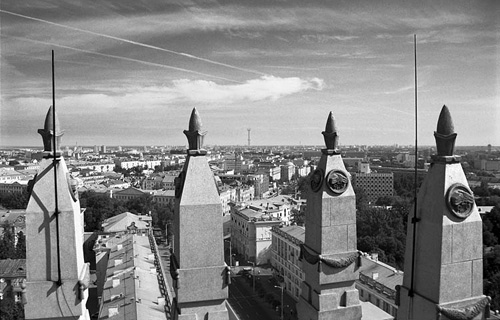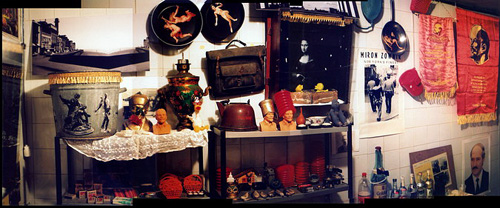Most Belarusian contemporary artists have long since left the country. Why are these two still around?
It sounds like the start of a bad joke — a Russian sends an American to Minsk in search of contemporary art — and initial signs were not promising. When I found an introduction to the post-Soviet Belarusian scene, written by the renowned expert on the topic, I was greeted by the cheery proclamation: «Aside from a few interesting personalities, Belarusian art does not exist.»By the time I was sat in a makeshift café on the fourth floor of the city’s main railway station one cold Monday morning sharing a coffee and a barely recognizable cheburek with Alexander Pushkin, the joke seemed to have come full circle. The long-haired, gold-toothed Pushkin had come down from the tiny village of Bobr 125 kilometers away and generously offered me a crash course in the art of this land that time forgot. Dressed in an old overcoat, a fraying trilby, and an embroidered peasant shirt, he himself half seemed to have stepped out of the 1950s as he removed a worn envelope and a yellowing address-book from his antique black briefcase.
«There are two kinds of Belarusian artists,» he said, drawing a line down the back of the envelope, «official and unofficial. But it’s not a question of ‘this art is good, this art is bad,’ it’s a question of complicity and conformism.» Conformism is perhaps not strong enough a word. Top of the list on the left-hand side was Mikhail Andreevich Savitsky — one of the five Heroes of Belarus alongside the metropolitan and the chairman of the kolkhoz — who still dutifully churns out portraits of Stalin at the ripe old age of 86. «They all lie, these old men,» grinned Pushkin, «they made the decision to shake the hand, accept the awards, and not question anything.»
The first thing Russians will say about Belarus — and all many will claim to know — is that the half-forgotten neighbor to the west is a country entirely unchanged since the Soviet Union known only for its tractors, potatoes, and its president’s kitchy personality cult. But time there seems less to have stopped than taken on a bizarre, lost quality of its own. Almost entirely destroyed during World War II, the Stalinist reservation of Minsk is cold, forbidding. Drab stone government buildings dominate its skyline, lit up at night by unearthly colored lights from tall Soviet hotels. Its eerily quiet streets are almost completely free of advertising except for the state's charmingly tacky propaganda posters of kolkhoz workers, homely girls in drab white underwear, ragged groups of children in military uniform, and tractors driving past the ubiquitous Khrushchev era apartment blocks. The only sounds on its dull and homogenous metro are the grumbling of the trains and tinny noises from the video screens above the tracks.
In an environment like this — particularly given the Lukashenko regime’s broad popularity — it’s difficult to imagine contemporary art existing at all. By and large, it does not. Belarus is the only country in Europe and perhaps the entire industrialized world without a gallery; bar the occasional small orders officially vetted and ideologically appropriate artists receive from the state, which are hardly enough to live on and take months to arrive, its art market is nonexistent; its regressive totalitarian ideology, village-nurtured social consciousness and patriarchal social structure make the development of a cultural dialogue all but impossible; and the parochial disdain of Russians for their tiny neighbor combines with an almost complete ignorance from the West to deny its unofficial artists a model to build on, a place in the sun to aspire to, or a well-wisher to please.
«If you're an artist and you live in Belarus, you will inevitably be a black sheep, because this is the land of athletic-Russian Orthodox holidays celebrating KOLKHOZ FASCISM. Why haven't they destroyed you yet? Why haven't you emigrated, why hasn't the Dictator forced to collaborate, the dictator who Russia brought to power; it's only a matter of time,» Pushkin recounted.
Of course, it wasn’t always like this. Pushkin still speaks fondly of the Vitebsk avant-garde by Marc Chagall and Kazimir Malevich, but they went first where many of those from the small but lively and diverse scene that grew under the enthusiasm of perestroika and the early 1990s followed — abroad. As time passed Belarus by, the small handful of galleries that sprung up around it died out, and the art world along with it. The only officially supported exhibition space is the Soviet-era and still pallidly Soviet-esque Museum of Contemporary Art, which, as the joke goes, isn't a museum and doesn't show contemporary art. What venues are available feel like sad parodies of Winzavod, with its blue-chip gallery spaces, fashion boutiques, Falanster branch and trendy cafes — and there are all of two of them. Neither of them are galleries in the proper sense of the word, and neither of them would claim to be. «Wishful Thinking,» one of them is called, but it is actually an unpreposessing cozy café run by an old lady, hidden away on a side-street in an industrial area with a four-person stage for live music and rotating series of exhibitions on its walls — by the nature of the place easily mistakable for background decoration. The Pozdemka Gallery on Independence Prospect, the city's main street, is more in touch with the local hipsters, but mainly in the sense that it survives on the clothes, chotchkes and trinkets, music, books, and films it sells as opposed to the artwork.
It was there that I met with Artur Klinov — top of Pushkin's «unofficial» list, one of the few Belarusian artists recognized abroad (i.e. at all) and editor of the country's only contemporary art magazine, pARTizan. He himself has not held an exhibition in Belarus for the last ten years, and explains Belarusian art's отчайянное положение desperate situation as follows: «It's a big mystery. In terms of size and population, Minsk is a lot like Kiev, but if there are at least a dozen normal galleries there, here, there's nothing. Pozdemka has the chance of becoming, and has been quietly developing in that direction for five years or so. But that is an exception. It's a crazy situation, it isn't normal, but for us, it's reality.»
The obvious conclusion from looking at Klinov's work is to call him a nationalist, be it his refusal to publish in Russian or his land-art series made out of straw. But he claimed in response to this: «I am a fan of the figure of the partisan; this is almost like a Belorussian national brand, familiar, famous, and adequate to local conditions. Since there is no infrastructure and no support, a Belorussian author will have to use some kind of partisan strategy to function and survive. He acts not only as an author, but as a manager, curator, critic, and dealer.»
For Klinov, the partisan struggle is born more out of necessity than an active choice, a struggle less against something or someone than for the artist's own right to exist. Pushkin, on the other hand, is an open nationalist and has fully declared war on «kolkhoz fascism». He flies the old red-and-white Belarusian flag from his home, passionately defends the Belarusian language slowly but surely being phased out by Lukashenko (his wife teaches it in school), and redecorates or renews decaying frescoes in village churches, sometimes painting in Lukashenko himself. Proudly showing me his veteran’s card (which really does have him as Alexandr Mikhailovich Pushkin), he explained his bravura by his service in Afghanistan in the 1980s: «I was the only one in my whole battalion to become an artist! And after leaving the army, I really wanted to live. I was no longer afraid of the KGB, the government, or the militia. It was only 20 years after I left the army that I understood that I had to paint icons for the churches and chapels of Belorus as penance for being so brutal once, even in a foreign, distant land.»
Pushkin, however, is known foremost for his performances, largely due to the instant notoriety he received in 1999 for the now-legendary «Present for the President». On the date Lukashenko's first term in office officially expired, he appeared in peasant costume outside the presidential palace driving a wheelbarrow full of manure, on top of which lay a pile of Belarusian banknotes bearing Soviet symbols reintroduced by Lukashenko, and a portrait of Lukashenko himself. In the few seconds before he was arrested, beatened, and fined $4000, he spilled the wheelbarrow's contents onto the ground and drove a pitchfork straight into Lukashenko's face. «This is a special Belorussian form of art happening, a cheerful, humorous way of expressing protest against the Moscow puppet's usurpations, without blowing up cars. It will go down in history as a justification of that part of the Belorussian intellgentsia, and artists in particular, who did not silently concede to the epoch of Lawlessness.»
Perhaps unsurprisingly, Pushkin was arrested, beaten, and fined, not for the first or the last time. But this one-man struggle seems to amuse him more than anything else. Still grinning, he showed me a paper brochure of a performance on Independence Day last year, in which he stood by the side of a road in his village with bird houses styled after the red-and-white national flag, the European union flag, and other «symbols of freedom». This lasted all of 45 minutes before the police came to arrest him — which in his opinion made it a complete success:
«In an unfree country, it is an administratively punishable deed to exhibit bird houses with a subtext on Independence Day; it entails a sizeable fine. And the performance's participants become both militia men and judges without knowing it, but feeling the absurdity of the situation that they are in.»
Performance in Belarus has a special resonance for many as the last genre they can turn to, whether as the most direct way of attacking the government or as the only real way to attract public attention to unofficial art. Pushkin and other Belarusians frequently participate both in European performance festivals, provided they have paid their fines and can leave the country, and in the Belarusian festival held once a year in the small town of Navinki. «In an unfree country, everyone speaks in Aesopian language,» he said, «and this is the only form of free creativity that is not punished harshly.»
Klinov, not a performer himself, was less enthusiastic. «There was a wave in the 1990s after which everybody started doing this. The word became popular, so that any party became a performance on the level of everyday language.»
It seemed to me that there are few places for the Belarusian artist to go, but out. By their resistance to the exodus, Klinov and Pushkin are anomalies — but on reflection I felt this was as much due to a sentimental connection to their system as to their desire to change it. Klinov in particular sees Minsk as the last of a dying breed. This much is evident from his photo-project The City of the Sun, which chronicles the empty stone streets in sentimental and even mystical fashion. «This is a present of the great utopia that was realized here like a pyramid that came down to the earth as a gift. It is very theatrical and decorative, which is the only way to realize a utopia; you don't try to answer reality, but make a great image. Utopias can force the people who live there to believe. I am afraid that in 20 years, it just won't be here anymore. Barbarians — they call themselves investors — are already on the way with their immoral money, arguing about what they want, and there is almost no chance of survival in the face of that onslaught.»
Most troubling was the evidence that Belarus's young artists are not only emotionally and creatively distanced from the 1990s non-conformist generation, but, nascent and myopic as their scene is at best, already falling under the influence of the worst glossy elements of Western art. I saw this on the last day of a weekend-long series in Podzemka called «Everything You Ever Wanted to Know About Contemporary Art But Were Afraid to Ask», which featured a video duo under the strange moniker of An Angelico. This was set up as a public discussion — in Russian, notably — of new works the two young men had made for nightclub projector screens and «remixed» as video-art. I was somewhat surprised they have nightclubs in Belarus at all, but more shocked by how vapid and banal the group's works were. To the strains of generic, forgettable ambient electronica, they showed models first longingly gazing at horizons over fields or out of bedroom windows, then joyously dancing in various states of undress. This brought out the appropriate disdain from older members of the audience, but whipped up younger spectators into a kind of rapturous frenzy.
One the one hand, in the absence of a real арт-процесс you could hardly expect them to know any better. But ultimately this has nothing to do with Lukashenko — Belarusians have the full resources of the internet at their disposal — and everything to do with their desperate need for a cultural dialogue. Without that, the Belarusian artist will have to fight for himself. Klinov agreed: «For centuries, culture here has based on paradoxes of some sort. Culture does not die, it survives, generating its own heroes. So this earth is still giving rise to cultural heroes, and as long as it keeps doing so, there is some sort of future. Cultural heroes will save this country. It's all based on people who say fuck you all against all odds, who go their own way, no matter who tries to stop them.»
Ссылки
- 29.06Московская биеннале молодого искусства откроется 11 июля
- 28.06«Райские врата» Гиберти вновь откроются взору публики
- 27.06Гостем «Архстояния» будет Дзюнья Исигами
- 26.06Берлинской биеннале управляет ассамблея
- 25.06Объявлен шорт-лист Future Generation Art Prize
Самое читаемое
- 1. «Кармен» Дэвида Паунтни и Юрия Темирканова 3451845
- 2. Открылся фестиваль «2-in-1» 2343436
- 3. Норильск. Май 1268783
- 4. Самый влиятельный интеллектуал России 897719
- 5. Закоротило 822179
- 6. Не может прожить без ирисок 782662
- 7. Топ-5: фильмы для взрослых 759461
- 8. Коблы и малолетки 741037
- 9. Затворник. Но пятипалый 471654
- 10. ЖП и крепостное право 407978
- 11. Патрисия Томпсон: «Чтобы Маяковский не уехал к нам с мамой в Америку, Лиля подстроила ему встречу с Татьяной Яковлевой» 403265
- 12. «Рок-клуб твой неправильно живет» 370663

